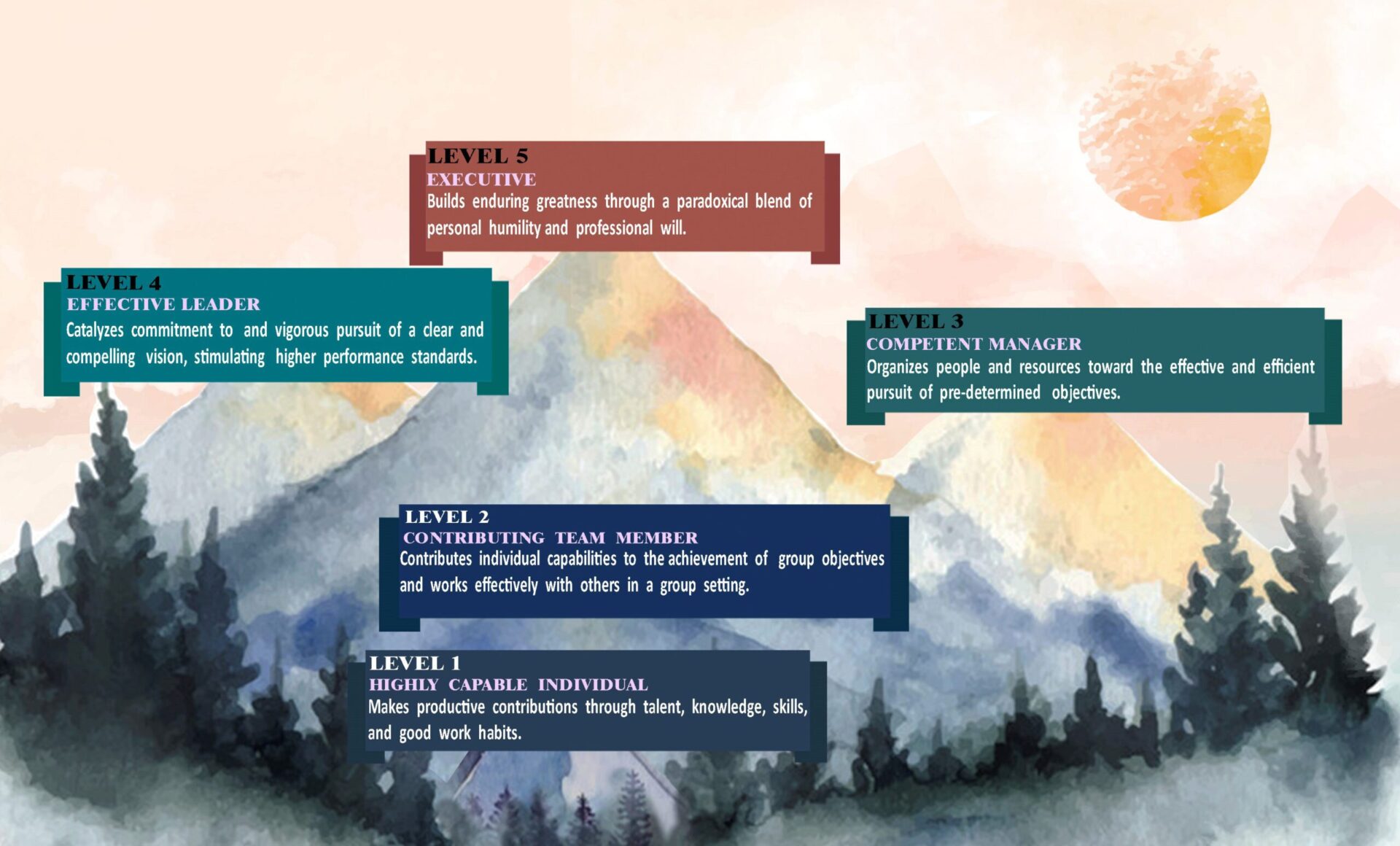What has a ‘good to great’ company got to do with how to ‘Build A Level 5 Child’ and, to a lesser extent, parenting or children? My apologies; I can offer no direct or logical answer. However, I believe I may just have uncovered the blue pill moment on how to build a level 5 child.
This is not a magical blue pill moment that will uncover this mythical talent or gifted gene, but methods that can be taught to kids from the moment they say ‘mum’ or ‘dad’. The only downside is that the parent must understand the methods and apply them to the rearing of their child. No magical pill then, just hard work over years to get the same outcome as the mystical, magical blue pill (I can easily substitute a blue pill for a red pill, they are the same, but blue is my favourite colour).
What science leads us to ‘Build A Level 5 Child’?
The blue pill in question is a study conducted by Jim Collins; he is well known in the business field for conducting deep analysis into businesses and companies. After years of meticulous research, he offers pragmatic solutions on how businesses and companies can become successful or maintain good health.
His first book, ‘Built to Last,’ catapulted him into a person of relevance. However, my blue pill analogy on how to ‘build a level 5 child’ comes from his latest book ‘Good to Great’. In this book, Jim and his team of researchers uncover the underlying variables that enable every type of company to move from good to great whilst also showing why certain companies remain at good.
Books, in my view, are great equalisers; what you take from them are individualistic when reading; I tend to relate whatever I am absorbing to my interest and how I can apply my newfound knowledge to those things that grip my brain. My latest gem comes from ‘Good to Great, which I believe if understood and applied to a child’s upbringing, has the potential to develop them for future success.
These soft skills can set anyone (adults also), particularly children whose brains are still malleable.
Level 5 Leadership, A Level 5 Child
One of the key findings from Jim Collins 5 year study into top companies that moved from good to great centred around the company’s CEO what we could liken to the godfather. They used finely tuned methods applied with a forensic comb, over 20 years of a company’s financial data and other available data (qualitative and quantitative).
What they found from their assessment of the companies that progressed from ‘good to great’ had what they called the “Level 5 Leadership” qualities. Jim Collins and the team’s findings were not ground-breaking in terms of the words. However, it was ground-breaking regarding what we think of as what leaders are made of. It was interesting to note that these identified abilities are qualities that we are all aware of; however, we fail to practice them for ourselves.
Fossil mentally comes to the tip of my lips when trying to change the mind or habits of adults; speak to any government or marketing company, and they will indicate this to be an accurate observation. For example, think of the current worldwide push to improve the obesity epidemic or sedentary lifestyles we live in modern times; the target is to educate the young.
Whilst all of my insights gleaned from ‘Good to Great’ applies to adults, I tend to skew it for the benefit of parenting children; kids are the future, right?.

Collins and his research team found these Level 5 CEO’s to have no sense of self-importance; they were not your VIP or celebrity CEO’s, they cared very little for hero status. Instead, they found these leaders to have the perfect blend of extreme personal humility with intense professionalism. So low self-importance and humility are not bad things, are they? How good would it be if we instilled in our kids this ability?
Many conflicts self-confidence with self-importance, throwing humility out with the baby in the bathtub. From observation, you see many people always cultivating attention; this subsequently gets passed on to the kids. Just how good would it be if we could instil humility and teach our kids the ability to push for what they want. Collins and his team came to define these individuals as;
… channel their ego needs away from themselves and into the larger goal of building a great company. It is not that Level 5 leaders have ego self-interest. Indeed, they are incredibly ambitious – but the ambition is first and foremost for the institution, not themselves
This is how they summed up their findings; see diagram below;

How can we relate these findings to raising children for the future?
These leaders were found to be a cut against the grain of conventional wisdom. This is the fallacy that you must be a larger-than-life person with a big personality to be successful in life. These exception individual leaders all possessed the five skills below. I have tried, wherever possible, to adapt the findings as to how they may be applied to a child. I have inserted these adaptations that were applicable in brackets.
1. Humility + Will = Level 5 (Humility + Will = A Good Human Being)
Regardless of your background, ethnicity, colour, or creed, being humble and having a drive is a sure way to progress in life. Collins and the team found the leaders to exhibit duality; they were modest and wilful, and humble and fearless. They never let their personal ego get in the way of the more significant cause.
2. Ambition for the Company: Setting Up Successors for Success (Ambition for Yourself and Others: Setting Up Both You and Those Around You for Success)
Placing others’ needs above your own is hard enough as an adult but as a child? No chance! I am sure you have observed this with your kids when their friends are around, and they refuse to share their toys. I am sure we have all observed this on buses, in playgrounds, at school gates or just in passing, children’s inability to want to share.
Collins and his team found that the companies that remained ‘good’ or’ worse’ set the company up for failure. They did not want the next leader to outdo them. However, the Level 5 leaders want to see the company excel long after leaving the role. One of the CEOs had this to say;
I want to look out from my porch at one of the great companies in the world someday and be able to say, ‘I used to work there.
It is all about the company or others; this surely should be a motive when rearing children. If we can teach our children from an early stage, just imagine the ending? My guess, better than what we are achieving now!
3. Compelling Modesty
It should NOT be about you; this is the level of modesty the great leaders possess. The research group found that these leaders didn’t talk about themselves; there was no ‘I’s’, but just ‘we or ‘they’. As soon as the research team dig deeper into their personalities, the leaders will simply deflect the discussions about their own contributions and onto others.
I have seen this too often in my own life; colleagues, bosses, myself, sportsmen and women, take that fall from the mountaintop as soon as modesty leaves the room. Helping kids understand this concept can only benefit; placing others first helps avoid being about you.
4. Unwavering Resolve… to Do What Must Be Done
I like most about these findings that being modest and humble does not imply success. Collins and his team found that these leaders had ferocious resolve; they were determined to do whatever was needed to make the companies great. Teaching your kids they must be humble does not mean becoming a doormat.
This is a classic case of duplicity, knowing when to be friendly and knowing when to grit your teeth. Teaching this to an adult in later years is an almost impossible task; however, children can hoover this up if taught from early years.
5. The Window and Mirror
Mirror and the window! This is classic; the Level 5 leaders were all observed to practice the window and mirror analogy.
The level 5 leaders all looked out of the window to apportion credit (factors outside themselves) when things went well. And in situations where they cannot find a specific person or event to give credit to, they credit good luck. Yet, at the same time, they look in the mirror to apportion responsibility, never blaming bad luck or others when things go poorly. How good is that? We are far too quick to blame others when things go wrong and take all the plaudits when praises are in the offering.
Kids have a chance if we can somehow figure out how to instil some of these Level 5 leadership qualities. Want to ‘Build A Level 5 Child’? Learn and understand the five qualities above, then teach your kids them!
Sources
- Jim Collins Website [Accessed 20 January 2022]
- Jim Collins (4 October 2001) “Good to Great”, Random House Business


